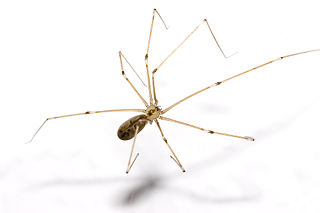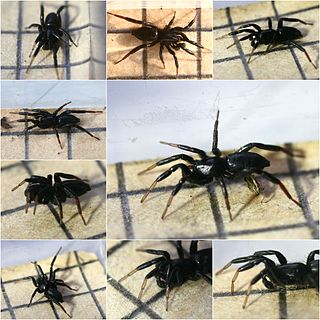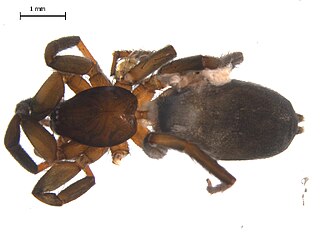
The Mygalomorphae, or mygalomorphs, are an infraorder of spiders. The name is derived from the Greek mygalē, meaning "shrew", plus morphē meaning form or shape. An older name for the group is Orthognatha, derived from the orientation of the fangs which point straight down and do not cross each other. In 1802, Charles Athanase Walckenaer separated mygalomorph spiders into a separate genus, Mygale, leaving all other spiders in Aranea.

The Pholcidae are a family of araneomorph spiders. The family contains over 1,800 pholcids, including those commonly known as cellar spider, daddy long-legs spider, granddaddy long-legs spider, carpenter spider, daddy long-legger, vibrating spider and skull spider. The family, first described by Carl Ludwig Koch in 1850, is divided into 94 genera.

Ground spiders comprise Gnaphosidae, the seventh largest spider family with nearly 2,000 described species in over 100 genera distributed worldwide. There are 105 species known to central Europe, and common genera include Gnaphosa, Drassodes, Micaria, Cesonia, Zelotes and many others. They are closely related to Clubionidae. At present, no ground spiders are known to be seriously venomous to humans.

Drassyllus is a genus of ground spiders that was first described by R. V. Chamberlin in 1922.
Drassyllus lepidus is a spider in the family Gnaphosidae, in the infraorder Araneomorphae . The distribution range of Drassyllus lepidus includes the USA and Mexico.
Azilia affinis is a species of long-jawed orb weaver in the family of spiders known as Tetragnathidae. It is found in a range from the United States to Panama.

Olios giganteus is a species of giant crab spider in the family Sparassidae. It is found in the United States and Mexico.

Castianeira trilineata is a species of true spider in the family Corinnidae. It is found in the United States and Canada.
Calymmaria persica is a species of true spider in the family Cybaeidae. It is found in the United States.
Castianeira thalia is a species of true spider in the family Corinnidae. It is found in the United States.

Gnaphosa sericata is a species of ground spider in the family Gnaphosidae. It is found in a range from the United States to Guatemala and Cuba.
Drassyllus novus is a species of ground spider in the family Gnaphosidae. It is found in the United States and Canada.
Drassyllus covensis is a species of ground spider in the family Gnaphosidae. It is found in the United States.
Drassyllus niger is a species of ground spider in the family Gnaphosidae. It is found in the United States and Canada.
Drassyllus fallens is a species of ground spider in the family Gnaphosidae. It is found in the United States and Canada.

Drassyllus insularis is a species of ground spider in the family Gnaphosidae. It is found in North America.
Drassyllus depressus is a species of ground spider in the family Gnaphosidae. It is found in the United States and Canada.
Drassyllus creolus is a species of ground spider in the family Gnaphosidae. It is found in the United States and Canada.
Drassyllus aprilinus is a species of ground spider in the family Gnaphosidae. It is found in the United States and Mexico.







